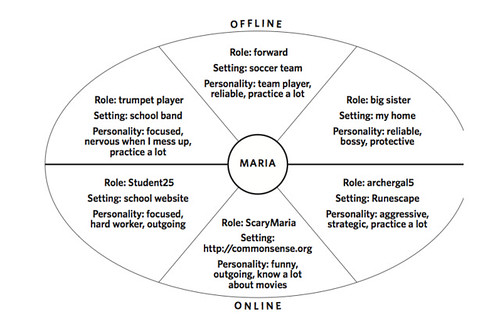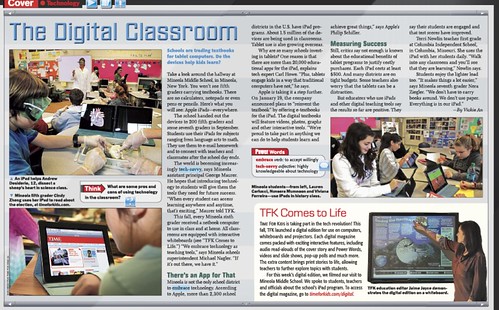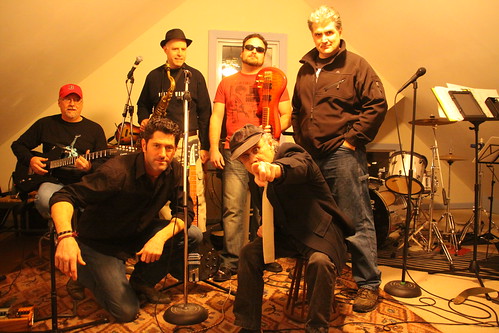I came across this parody by Mad Magazine, and it seems to dovetail nicely with my unit right now on Digital Lives.

Peace (in the funny),
Kevin

(Taken from the CommonSense Media handout: Offline/Online Me)
We spent our second day in our Digital Lives unit talking about identity. For my 11 and 12 year old students, this can be a pretty complex concept, particularly when we are thinking about how we make shifts in our personality and the way we want to the world to perceive us based on where we are. Once again, the CommonSense Media site curriculum around digital citizenship has been a rich trove to pull from, including an interesting video about how kids represent themselves (and not always for the good) and a useful handout that breaks down how one student represents themselves online and offline.
The video and the handout led to interesting conversations in my classroom throughout the day, leading to an activity around the creation of avatars for their Glogster accounts. Their mission: create a visual representation of themselves so that if I, or anyone else, were to ask why an avatar was chosen or created, they could make a clear connection to some interest or hobby or facet of themselves. It can’t be that the avatar is cool. It has to be there for a reason.
But back to our discussions for a minute. Here are some vignettes that stayed with me.
Peace (in the shift),
Kevin
PS — Here is a good resource collection from National Writing Project’s Digital Is about identity.
At the holidays, I received the Steve Jobs biography by Walter Isaacson. And while the story was familiar — I already knew much of Jobs’ history from other books and profiles — I still found it pretty fascinating. Let’s face it: if Jobs were our boss, we would have strangled him. If Jobs were our principal, we might have revolved against him. His temperament and lack of emotional connections, and drive to create his vision or else, made his companies at least very interesting to watch. But I would have hated to work under him.
The bio does a nice job of peeling the outer layer off Jobs, though, and allows us to understanding him a bit more through the very personal interviews that Jobs granted Isaacson. For me, I was most fascinated by his intense desire for design, and how that need for intuitive design elements shaped all of the products he would be putting into the market — from the devices that hold music to the stores that sell machines, and even in the layout of the Pixar offices. Design considerations also went into the insides of devices — things most people would never see. So much of what we see is so ugly, but not Apple products.
Isaacson nicely explores this area of Jobs’ life, and how that need for perfect design affected his dealings with other people. (And it is also so intriguing the parts where we see Jobs and Bill Gates interacting, and how different their approaches were to technology – particularly around design: Gates could not understand the fuss and Jobs could not comprehend how one could not fuss over it. That dichotomy could be a whole book in itself. I’d love to see a bio on Gates that goes as deep as Isaacson goes here, but somehow, I doubt that will ever happen. He’s not that kind of person, as far as I can tell.).
Two weeks ago, I got a comic book biography of Jobs. Needless to say, Steve Jobs: Co-founder of Apple by Bluewater Productions was a lot thinner. But the comic book bio touched on some important moments of Jobs’ life, and accomplishments, and does not quite skirt his explosive personality, but doesn’t dwell on it much, either. Reading the comic book version after Isaacson’s version was like watching a highlights real. I suppose if you have students interested in Steve Jobs, and the biography is just too much, the comic book version might be worth putting into their hands. You can tell, though, that the publisher rushed to get it onto the market to ride the wave of interest following Jobs’ death and Isaacson’s book. I found a few proofreading errors, and the writing is weak at times.
Both of these books give a view of Jobs as someone who has made a mark on modern life, and you can’t argue against that.
Peace (in the bio),
Kevin

We just launched into a unit (a new one for me) around Digital Lives, which will cover such topics as safety, personal information, social networking, passwords and more. I am mostly adapting a great curriculum developed by CommonSense Media, which has some interesting videos, lesson plans and activities. Yesterday, I began by posting a huge icon with the words “digital footprint” on the interactive board, and then we began to chat about what that meant.
Most had no idea. And once we began discussing the digital debris they leave behind at websites, I could already see some eyes opening up. Clearly, they don’t think much about their digital identity when they are online, and they are online a lot. Facebook, Youtube, and many other sites form the basis of what they do when they are on the computer. Very little computer time is offline.
As it turns out, this week’s Time for Kids magazine was perfectly tailored to begin our discussion. The topic of the main article was about how schools are starting to use tablet computers and technology in order to replace textbooks and inform instruction. They were quite interested in the programs where students get iPads for the year. We then went over the results of a survey I gave them two weeks ago about their own habits of technology. I paused at places where I have seen changes this year (more mobile devices, more confidence in their technical savvy, more viewing of videos online, etc.) and we had a long discussion about Facebook and password protection (to be continued another day).
We ended up talking about avatars, and how one represents oneself in an online space. They have some work to do around brainstorming an avatar for themselves, and then we will be doing some work around avatar creation on Wednesday, using our Glogster community as a place to experiment with representing themselves in an online environment.
Here are some of my notes from our far-ranging conversations during the classes yesterday:
I’m really impressed by their insights, and thinking, and I look forward to more of these discussions. At ages 11 and 12, this is the time we want them to be thinking along these lines. I want them to be critical thinkers, and critical users of technology. However, as I stressed many times, this is also not to freak them out, and make them so nervous they don’t want to go online anytime. It’s all about managing their identity and my aim is show them some tools to do that.
Peace (in the footprints),
Kevin
My son and I were about 25 pages into Gregor the Overlander as a read-aloud when I finally realized that the writer — Suzanne Collins — is the writer of The Hunger Games, too. It was an interesting connections — Gregor was one of her first series, and Collins notes in the book that she was inspired to write Gregor after thinking of Alice in Wonderland, and how her fall into the rabbit hole opened up a portal to a strange world.
Gregor the Overlander tells the story of Gregor, and his little sister, Boots, who fall through a grate in their New York City laundry room, and land in the Underland — a world below the surface of the city. Here, huge rats, cockroaches, bats and more live with a forgotten band of human refugees, and the world is in danger. A prophecy says a hero will come to save the day, and of course, it is Gregor, on a mission to rescue his father (who has been captured by the evil rats).
I can’t say that Gregor is all that original. Even my seven-year-old son asked why so many stories have the sons saving their fathers (to which I replied that I expect him to save me if I ever get captured by evil rats or, as in Summerland, a trickster god. He was non-committal – which makes me a little nervous). And I feel as if Neil Gaiman did a better job of this underworld with his Neverwhere novel, albeit for an older reader. But still, for the age level, Gregor moved along at nice pace, with pretty decent characters, and enough hints to keep the series going.
As luck with have it, a neighbor has the entire series of Gregor and are eager to lend them to us, to share the story. So, I guess we’re going back into the world beneath the streets to continue the story.
Peace (in the world beneath the world),
Kevin
It’s not easy, living in the heart of New England being a diehard New York sports fan. In baseball season, my Yankees’ spirit gets bashed left and right by the Red Sox fans who take delight in punching my buttons — in school and at home (and yes, all in good fun). Last night, I was one of only a few Giants fans in a party full of Patriots fans, and I was the lone New York cheerleader in my house when we came home to watch the second half. My sons went to bed depressed.
I was fine.
🙂
I expect some tired faces today in class with my students, most of whom are rabid Patriots’ fans, and I will be sure to just tweak the young fans just enough … but I won’t wear my Giants’ shirt today to school. Sometimes, you have to pull back. But I just might wear my tie …
Peace (in the victory),
Kevin
 If you have been the main organizer for a technology-infused event that brings together people you want to bring together, you know know how much stress goes into it. You wake up early that morning and think: nothing’s going to work today. The Internet will be down. The computers will be funky. People will get lost and won’t show …..
If you have been the main organizer for a technology-infused event that brings together people you want to bring together, you know know how much stress goes into it. You wake up early that morning and think: nothing’s going to work today. The Internet will be down. The computers will be funky. People will get lost and won’t show …..

That was me, yesterday morning (earlier than I want to say), as we held our Western Massachusetts Writing Project event that focused in on pop culture, technology and writing and the Common Core standards (now adopted by our state). Everything was perfect, though. The host school — West Springfield Middle School — is a fabulous facility, with three adjacent spaces that we used; almost everyone who signed up, arrived (and then some); our high school students who we brought in as our keynote speakers were fabulous; and the participants (about 25 people plus about 8 WMWP presenters) felt as if they could have used a few more hours exploring the themes and sites we shared with them.
Our technology team at WMWP led the event, with presenters coming from our ranks, and we explored the literacy in the lives of our students outside of school, the impact of technology on learning, and then breakout sessions took place for social networking (with Edmodo), digital storytelling (with Animoto and Voicethread), and gaming (with Gamestar Mechanic). Lots of people wanted the digital storytelling session, so we had some juggling to do, and it reminds us that teachers are looking for writing to be the very center of student work. There is high interest right now in digital storytelling, and free tools (which is what we focused on). We also made connections between our event and the national Digital Learning Day that just passed.
Our keynote speakers were from an organization called Video Vanguard (part of a Youth Action Coalition), and the two high school students were articulate and passionate and insightful about the ways that young people use media and technology. They shared a video project they recently completed in which they traveled to New York to observe the Occupy Wall Street movement, and focused a video on gender inqualities in the workplace. They interviewed people on the streets, and edited it into a powerful 5-minute video. It was full of researched information, and point-of-view, and video composition. What a great piece of art to share.
And it set the tone for the day, too, particularly when the students urged us teachers to “pay attention” to our students, and to find out what they are doing by forging personal relationships with them. Make connections, they told us, and ask questions. “Personal connections. It makes a difference,” Katie said.
Peace (in the sharing),
Kevin
In preparation for a workshop this morning around game design and the new Common Core, I put out a call for friends in my various networks to add to a Wallwisher about the possibilities of gaming. There are some great ideas on this wall! Thanks to everyone who added a thought to the project. I appreciate it.
Peace (on the wall),
Kevin
Well, my son and I finished up our read aloud of the NIMH series with the third installment — RT, Margaret and the Rats of NIMH by Jane Leslie Connly — and while it was enjoyable, I didn’t feel it held quite the same power as the first two (and nothing compares to the first one). It may be that introducing humans as the main characters instead of animals took away some of the magical qualities of the story. Or it may be that the plot device — two kids lost in the woods, rescued by the rats, have to keep the secret — just didn’t have quite enough conflict to keep the novel going as much as the other two did.
That said, my son loved it. He is quite sad that the series is now over, and we both chewed over some of the mysteries left unexplained in this third book – where has Nicodemus gone (he is nearing death in the book and has a “journey” that he embarks on) and where have the rats gone (when the kids take adults to Thorn Valley, the rats’ home is deserted and more).
Still, jumping into the world of the rats and their adventures, and concerns, is highly entertaining and this third book still keeps that part of the story alive, and allows you to think about rats in a different way. It also makes you wonder about those scientists in their labs, using rats and mice for experiments. At one point, my son said, “I don’t like the people in this book. Only the rats.”
But RT (real name: Artie) and Margaret as fine as characters, too, undergoing character changes as Margaret learns to be a bit more self-reliant and less harsh with the world, and Artie (who starts the book out as as a sort of “mute” child) begins to find his voice, and (in a nice touch) begins writing the story of the rats with a crayon on the wall of his closet, so that it won’t be forgotten.
Peace (in NIMH),
Kevin
My rock and roll band — Duke Rushmore — is now gearing up to get gigs, and we have a few possibilities. But they want a photo. So, we took a few of the other night. We don’t look too bad! (That’s me, in the back, with the hat on and the saxophone in hand).

Here is a video from our live performance last year. We’ve gotten a lot tighter since then.
Peace (in the rock and the roll),
Kevin